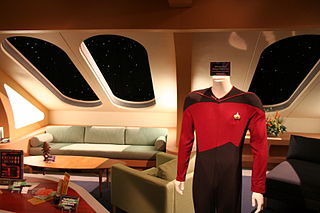
The Doctor, an Emergency Medical Hologram Mark I, is a fictional character from the television series Star Trek: Voyager, played by actor Robert Picardo. The character also appeared in Star Trek: First Contact, as well as the now-closed Star Trek: The Experience amusement exhibition at the Las Vegas Hilton. In the show, he is the "Chief Medical Officer" of the Starfleet spacecraft USS Voyager which as been stranded on the opposite side of the Galaxy as Earth, but the warp drive will take decades to get them back to Earth leading the crew to put Sickbay's temporary program on a permanent assignment. In they style of the Star Trek franchise exploration of artificial intelligence, a simple software program becomes a major character for the television show, which aired on United Paramount Network (UPN) between 1995 and 2001.

Kathryn Janeway is a fictional character in the Star Trek franchise. As the captain of the Starfleet starship USS Voyager, she was the lead character on the television series Star Trek: Voyager, and later a Starfleet admiral, as seen in the 2002 feature film Star Trek: Nemesis. Although other female captains had appeared in previous Star Trek episodes and other media, she is, to date, the only one to serve as the central character of a Star Trek TV series. She has also appeared in other media including books, movies, and video games. In all of her screen appearances, she was played by actress Kate Mulgrew.

Star Trek: Voyager is an American science fiction television series created by Rick Berman, Michael Piller, and Jeri Taylor. It originally aired between January 16, 1995 and May 23, 2001 on UPN, lasting for 172 episodes over seven seasons. The fifth series in the Star Trek franchise, it served as the fourth sequel to Star Trek: The Original Series. Set in the 24th century, when Earth is part of a United Federation of Planets, it follows the adventures of the Starfleet vessel USS Voyager, as it attempts to return home after being stranded in the Delta Quadrant on the far side of the Milky Way galaxy.

USS Voyager is the fictional Intrepid-class starship which is the primary setting of the science fiction television series Star Trek: Voyager. It is commanded by Captain Kathryn Janeway. Voyager was designed by Star Trek: Voyager production designer Richard D. James and illustrator Rick Sternbach. Most of the ship's on-screen appearances are computer-generated imagery (CGI), although models were also sometimes used. The ship's motto, as engraved on its dedication plaque, is a quote from the poem "Locksley Hall" by Alfred, Lord Tennyson: "For I dipt in to the future, far as human eye could see; Saw the vision of the world, and all the wonder that would be."
"Caretaker" is the pilot episode of the American science fiction television series Star Trek: Voyager. This series premiere was first broadcast as one double-length episode on January 16, 1995, as the first telecast of the fledgling UPN network. It was later split into two parts for syndication, but released in the original one-episode format. Set in the 24th century, the series follows the adventures of the Starfleet and Maquis crew of the starship USS Voyager after they were stranded in the Delta Quadrant far from the rest of the Federation.

Timothy Darrell Russ is an American actor, film director, screenwriter, and musician. He is known for his roles as Lieutenant Commander Tuvok on Star Trek: Voyager, as Frank on Samantha Who?, and as Principal Franklin, a recurring character on the Nickelodeon live-action teen sitcom iCarly.
Earth Spacedock is a fictional space station orbiting Earth in the Star Trek universe, designed originally by David Carson and Nilo Rodis of Industrial Light and Magic in the 1980s. It is large enough to contain several starships of that fictional universe, and in real life the Spacedock consisted of a series of sets, miniatures, and designs that were used for various films and television shows in the 1980s and 1990s. Written spacedock, it is first seen in the 1984 theater film Star Trek III: The Search for Spock, and subsequently in the fourth, fifth, and sixth Star Trek movies.
"Deadlock" is the 37th episode of Star Trek: Voyager, the 21st episode of the second season. In this television show, part of the Star Trek franchise, a Federation ship is stranded on the opposite side of the Galaxy as Earth in the late 2300s. On its way home the starship encounters many species of aliens and outer space phenomenon. In this episode their ship is split into two versions of itself sharing the same power source, while being attacked by a species of organ harvesting aliens known as the Vidiian.
"Blink of an Eye" is the twelfth episode from the sixth season of the science fiction television series Star Trek: Voyager, 130th episode overall.

Lists of Star Trek spacecraft is a comprehensive breakdown of the spacecraft featured in the Star Trek franchise.
Peter Lauritson is a long-time film producer and director and television producer and director who first became involved with the Star Trek franchise with Star Trek II: The Wrath of Khan. He went on to become a producer for Star Trek: The Next Generation, and supervising producer for Deep Space Nine, Voyager and Enterprise. He directed three episodes of those series, including the Hugo Award-winning "The Inner Light", as well as being second unit director for two Star Trek films.
"Unity" is the 17th episode of the third season of the American science fiction television series Star Trek: Voyager, the 59th episode overall. The episode first aired on the UPN network on February 12, 1997, as part of sweeps week. It was written by producer Kenneth Biller, and is the second episode to be directed by cast member Robert Duncan McNeill. It marked the first major appearance of the Borg in Voyager, which were kicked off with a teaser ending in the prior episode.
"The Disease" is the 111th episode of the science fiction television series Star Trek: Voyager, the 17th episode of the fifth season. The episode focuses on a plot with Harry Kim as USS Voyager encounters a unique civilization on an extremely large starship.
Star Trek is an American space opera media franchise based on the science fiction television series created by Gene Roddenberry. The first television series, simply called Star Trek and now referred to as "The Original Series", debuted in 1966 and aired for three seasons on NBC. It followed the interstellar adventures of Captain James T. Kirk and his crew aboard the starship USS Enterprise, a space exploration vessel built by the United Federation of Planets in the 23rd century. The Star Trek canon includes The Original Series, an animated series, five spin-off television series, the film franchise, and further adaptations in several media.

The Borg are a fictional alien group that appear as recurring antagonists in the Star Trek franchise. The Borg are cybernetic organisms, linked in a hive mind called "the Collective". The Borg co-opt the technology and knowledge of other alien species to the Collective through the process of "assimilation": forcibly transforming individual beings into "drones" by injecting nanoprobes into their bodies and surgically augmenting them with cybernetic components. The Borg's ultimate goal is "achieving perfection". Aside from being recurring antagonists in the Next Generation television series, they are depicted as the main threat in the film Star Trek: First Contact. In addition, they played major roles in the Voyager series and serve as the way home to the Alpha Quadrant for the isolated Federation starship USS Voyager. The first encounter between humans and the Borg is depicted in the 2nd season of the series Enterprise in the episode "Regeneration" in which the phrase "you will be assimilated; resistance is futile" is heard by the crew of the Enterprise for the first time.
Several characters within the Star Trek franchise, primary and secondary, often made crossover appearances between one live-action series and another. This included appearances of established characters on premiere episodes of new series, a few long-term transfers from one series to another, and even crossovers between Trek films and television. A few crossover appearances, such as that of Spock on The Next Generation and the time-travel of the crew of Deep Space Nine to the era of The Original Series were especially lauded by both fans and critics.







